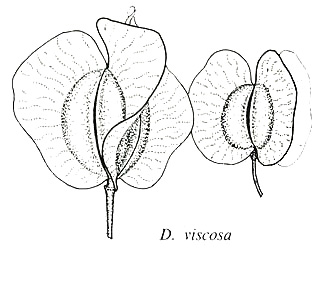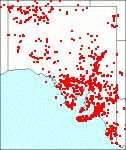|
Dodonaea viscosa
Citation:
Jacq., Enum. Pl. Carib. 19 (1760).
Synonymy: Not Applicable Common name: Sticky hop-bush, akeake.
Description:
Dioecious or polygamo-dioecious spreading or erect shrubs, 1-4 m high; leaves simple, sessile or petiolate, of variable shape from linear to obovate or spathulate, cuneate to angular-obovate, obtuse to acute, often with a short abrupt point, or rounded and mucronate, rarely irregularly 3-toothed at the apex, 1-10 x 0.1-2.5 cm (see subspecies for details), viscous, with flat glands, glabrous, margin entire to irregularly sinuolate to irregularly denticulate; petiole 1-20 mm long.
Flowers in terminal panicles; pedicels 3-9 mm long; sepals 3 or 4, lanceolate to ovate, 1.3-3 mm long, caducous; stamens usually 8, rarely as few as 6 or as many as 10; ovary pubescent or glabrous.
Capsule 3- or 4-winged, broad-elliptic to transverse-elliptic in lateral view, 8.5-28 x 11-28 mm, septifragally dehiscent, wings 3-10 mm broad, extending from the base to the apex of the capsule.

| Dodonaea viscosa capsule.
|
Image source: fig 423l in Jessop J.P. & Toelken H.R. (Ed.) 1986. Flora of South Australia (4th edn).
|
Published illustration:
West (1984) Brunonia 7:fig. 22, b-d.
|
|
Distribution:
|
all States. worldwide.
|
Conservation status:
native
Flowering time: Sept. — Jan.
|

SA Distribution Map based
on current data relating to
specimens held in the
State Herbarium of South Australia
|
Biology:
D. viscosa is a polymorphic species exhibiting variability in leaf morphology. Some populations contain individuals with leaf shapes intermediate between two subspecies. This is especially so in the higher rainfall areas of the south-east (SE), whereas in the arid and semi-arid areas leaf shape is much more constant.
Uses:
The hop-like fruits of D. viscosa were used by the early colonists as a substitute for true hops in making yeast and beer.
Key to Infraspecific taxa:
|
1. Leaves linear to narrow-oblong, 0.1-0.4 cm broad |
|
subsp. angustissima 12a. |
|
1. Leaves obovate or spathulate or cuneate to angular-obovate, not linear or narrow-oblong, 0.5-2.5 cm broad |
|
|
|
2. Leaves cuneate to angular-obovate, or narrow-obovate, lamina 1-3 cm long, usually with length:width less than 3.5:1, apex truncate or obtuse, usually with a short abrupt point or sometimes irregularly 2-3-toothed |
|
subsp. cuneata 12b. |
|
2. Leaves obovate to spathulate, lamina 2.5-7.5 cm long, usually with length:width more than 3.5:1 |
|
|
|
3. Leaves 1-2.5 cm broad, with the petiole 3.5-20 mm long, apex mucronate |
|
subsp. mucronata 12c. |
|
3. Leaves 0.6-1.6 cm broad, sessile or with the petiole 4-10 mm long, apex broad-acute to obtuse, sometimes with a short abrupt point |
|
subsp. spatulata 12d. |
Author:
Not yet available
|

